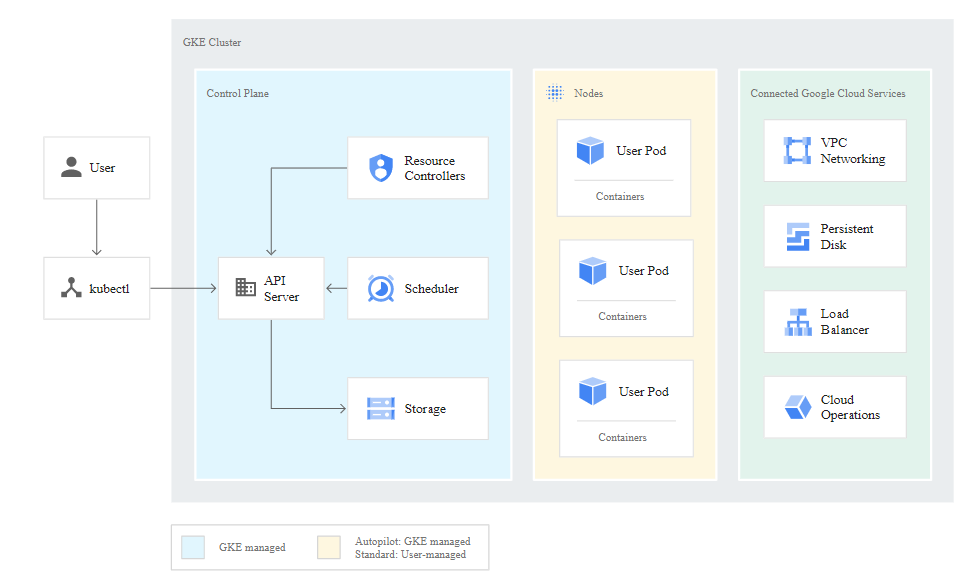Table of Contents
Introduction: Google Kubernetes Engine
Google Kubernetes Engine is an open-source and managed service known as GKE on the Google Cloud platform. Google Kubernetes Engine is used to deploy containerized applications at scale on Google’s Infrastructure. Kubernetes is best for those people who are looking for scalable, automated, and managed Kubernetes solutions. Kubernetes makes these workloads easy.

When we can use Kubernetes Engine (GKE)
Google Kubernetes Engine is managed containerized service, it allows you to focus on developing and deploying containerized applications while providing high availability, scalability and seamless interaction with Google Cloud Services. Here are some scenarios where we can use Kubernetes Engine:
Containerized Application Deployment
GKE provides an infrastructure to run your application which is packaged as containerized using Docker or any other containerized technologies, here you can use Google Kubernetes Engine. GKE provides a reliable and scalable infrastructure to run your containers.
Scalability and Elasticity
GKE is automated scalability according to traffic, you can define your application’s scaling policy based on metrics such as CPU utilisation or incoming traffic. For example, you can set scaling policies that state “If the CPU utilization of your application exceeds 70%, add more instances to manage the increased load.” GKE will handle the provisioning of increased instances automatically.
High Availability
GKE also provides high availability, GKE is run your application on multiple nodes so that its decreased latency and gives high availability. GKE also provides features like rolling updates and canary developments, these features reduce downtime during application updates.
Integration with Google Cloud Services
GKE integrates with Google Cloud Services such as Cloud Storage, Cloud SQL, Bigquery, and Pub/Sub. This integration allows you to take full advantage of the Google Cloud Platform.

Benefits of Google Kubernetes Engine|GKE
Here are some benefits that make Google Kubernetes Engine more special:
Platform Management
GKE simplifies platform management by providing fully-managed nodes with built-in hardening and the best configurations. In Autopilot mode, the Google Kubernetes engine automatically manages security measures and ensures that the cluster is up-to-date. With flexible maintenance windows and exclusions, you can configure upgrade type and scope according to your business needs. GKE also provide automatic scaling of nodes based on the number of pods in the cluster, ensuring the best resource utilization.
Enhanced Security
GKE gives the best security features to secure your application. There is a hardened node OS, called Container-Optimized OS it’s optimized to handle containerized workloads. GKE automatically apply security measures and upgrades the cluster to the new version.GKE is integrated with Google Cloud logging and monitoring tools through this you can monitor and analyze security-related events.
Cost-Optimization
Google Kubernetes Engine provides a cost-optimization feature that is based on your workloads. In autopilot mode, you pay only for the compute resources your running Pods request, allowing you to optimize costs based on actual usage. In GKE standard mode, you pay for all resources on nodes, regardless of Pod requests. GKE also offers the option to run fault-tolerant workloads on Spot Pods, which can significantly reduce costs for certain types of workloads.
Reliability and Availability
GKE provides a high level of reliability for your applications. GKE gives you a >99% monthly uptime Service Level Objective, ensuring minimal downtime to your cluster. In Autopilot mode, GKE manages both the nodes and the control plane, it reduces operational overhead and increases the overall reliability.
Multi-cluster Service Capabilities
GKE allows you to leverage multi-cluster service capabilities, enabling you to deploy and manage applications across multiple clusters. This feature enhances availability and fault tolerance by distributing your workload across multiple regions or zones. You can easily configure and manage multi-cluster services within GKE, providing flexibility and scalability for your applications.

Conclusion
GKE is a powerful platform that empowers organizations to leverage the full potential of Kubernetes for their applications. It streamlines platform management, enhances security, optimizes costs, ensures reliability, and enables multi-cluster deployment. With GKE, you can confidently deploy and manage your containerized applications, regardless of the scale or complexity. Its user-friendly interface and integration with Google Cloud services make it a valuable tool for both small teams and large enterprises. By choosing GKE, you can focus on accelerating your application development and delivering value to your users.

Leave a Reply